Megha Gupta1, Vincent S Gallicchio1*
1Department of Biological Sciences, College of Science, Clemson University, Clemson, SC 29636, USA
*Correspondence author: Vincent S Gallicchio, Department of Biological Sciences, College of Science, Clemson University, Clemson, SC 29636, USA; Email: [email protected]
Published Date: 24-02-2023
Copyright© 2023 by Gallicchio VS, et al. All rights reserved. This is an open access article distributed under the terms of the Creative Commons Attribution License, which permits unrestricted use, distribution, and reproduction in any medium, provided the original author and source are credited.
Abstract
Bipolar disorder is a mental disorder that affects hundreds of thousands of people worldwide. Common treatment options are cognitive, behavioral, and medicinal treatment, though medicinal treatment is shown to be most effective because the brain is shown to be “damaged.” This damage is evidence based on a significant reduction of gray matter in neural areas that enable and/or regulate bipolar-related symptoms. This is evident in immunological-related responses against the brain during a brain trauma or stroke, and similar clinical values are observed during episodes of psychosis, leading researchers to believe that drug treatment is beneficial to treat the misrepresented neurodegenerative disease. Lithium carbonate is a drug commonly used to treat bipolarism as it is proven to reduce the effects of mania and psychosis as well as serve to be prophylactic against episodes of depression. It is also shown to elevate levels of white blood cells through its influence on signaling pathways within the brain that encourage an increased granulocyte production. Though, as beneficial as it is to treat bipolar-related symptoms and potentially increase the immunological response within the body, its toxicity is quite dangerous in harmful amounts. Current research is now moving forward to continue the investigation of lithium on white blood cells.
Keywords: White Blood Cells; Stem Cell Proliferation; Bipolar Disorder; Lithium; Dementia
Abbreviations
AD: Alzheimer’s Disease; BBB: Blood Brain Barrier; BD: Bipolar Disorder; cAMP: Cyclic Adenosine Monophosphate; CNS: Central Nervous System; CSF: Cerebrospinal Fluid; DAG: Diacyglycerol; G-CSF: Granulocyte Colony Stimulating Factor; GSK-3: Glycogen Synthase Kinase 3; IP3: Inositol-1,4,5 Triphosphate; MARCKS: Myristoylated Alanine-Rich C-Kinase Substrate; MS: Multiple Sclerosis; NAA: N-Acetyl-Aspartate; PI-3K: Phosphoinositide 3 Kinase; PI: Phosphoinositol; PIP2: Phosphatidylinositol- 4,5 biphosphate; PKA: Protein Kinase A; PKC: Protein Kinase C; PLC: Phospholipase C
Introduction Formerly known as manic depression or manic-depressive illness, bipolar disorder is a mental illness associated with extreme shifts in mood, leading to depression during a “low” episode or mania/hypomania during an emotional “high” episode. This disorder globally affects 1 in 100 people, diagnosed with its different types: Bipolar I, Bipolar II, or the cyclothymic disorder. All three are associated with unusual shifts in concentration, activity levels, the ability to carry out daily tasks, and mood energy [1]. A common treatment is the combination of counseling and medication, with medications proven to be most effective (Fig. 1,2).

Figure 1: This figure displays the type of drugs commonly popular over the years and projects the “top” drugs in the near future [2].

Figure 2: This bar graph indicates the prevalence and burden of bipolar disorder, separated by male and female. Females are shown to be more commonly diagnosed with bipolarism than men [3].
One medication in particular, lithium, is the first line of defense when it comes to bipolar disorder due to its effectiveness in reducing the frequency and severity of manic episodes as well as being having a role in the prophylaxis of bipolar depression [4]. Lithium was discovered to have a link to bipolar disorder after Austrian scientist, John Cade, began collecting urine samples from people with schizophrenia, depression and mania after hypothesizing uric acid playing a role in “psychotic excitement” [5]. However, after experimenting with lithium, Cade noticed that the toxicity of his patients’ urine was reduced following the combination when used to dissolve the presence of uric acid crystals. Given in safe doses, lithium was able to decrease these crystals in guinea pigs. Back in the nineteenth century, lithium was frequently prescribed to treat gout but after his observations, Cade began to investigate the tranquilizing effects of lithium, going on to lead the discovery of lithium therapy for bipolar disorders. At the same time, it was noted that lithium toxicity could easily occur if not controlled or not under supervision [5]. The hematological side effects of lithium carbonate on blood are still ongoing, including action on as its risks of toxicity potentially conflict with studies that indicate an elevation in white blood cell count. This paper seeks to investigate lithium as a psychotropic drug and the mechanisms responsible for its hematological effects alongside the mechanisms that treat bipolar-related symptoms.
Discussion
Bipolar Disorder (BD) has been long associated with its extreme behavioral effects but uncommonly acknowledged as a neurodegenerative disorder. MRI scans done on patients with bipolar-related symptoms indicate atrophy of the brain most likely brought upon by neuronal/glial stress. Increased levels of stress cause manic-type symptoms as sensory activity associated with taking in information is suddenly blocked, allowing for an influx of neuronal information, causing slight atrophy of the brain [6]. Further research investigating the brains of patients compared to healthy brains indicate the reduction of brain volume in areas associated with mental regulation in BD subjects. The brain volume that specifically decreased was gray matter volume, having a hand in the dysregulation of emotional/cognitive processing in the amygdala and prefrontal cortex, both areas of neural diversity. A reduction of about forty percent was noted for the prefrontal cortex in subjects with bipolar ties in familial history, indicating a genetic predisposition. Abnormalities were noted in NAA, myoinositol, and choline, specifically in the areas of the basal ganglia, cingulate cortices, and hippocampus in subjects with BD. This is a significant observation because these substances, or markers, are associated to the coordination of various neurotrophic pathways. Another observation to point out is that these markers were significant in lithium therapy, playing key roles in the response of the treatment and indicating their state-dependence. Studies indicate BD patients presented high levels of the markers in the neural diversity areas mentioned prior to that which occurred during an episode of severe depression or mania. Naturally, these levels were not present in the healthy controls of the study but the key point to note is that these healthy levels were like the BD patients when subjected to a lithium treatment [7]. Further detail on how exactly lithium is able to prevent abnormal readings of clinical values is later explained (Fig. 3,4).

Figure 3: As one can observe, this imaging of an individual with bipolar disorder has structural abnormalities associated with the cortical and subcortical regions, indicating potential degradation over time from mood episodes [8].

Figure 4: A: left, indicates a CT scan of a healthy brain compared to B, right, in a BD-diagnosed patient [9,10]. This patient, at the time, was a 61-year-old female diagnosed with BD for the past 46 years. A and b in figure show axial images at the level of body of caudate and corona radiata, c shows a reformatted image in the frontal region, and d shows a sagittal reformatted region. These scans are reported to shows signs of atrophy of the cerebral parenchyma in the frontal region with the resultant prominence of the extra CSF spaces [10].
Greater research supports lymphocytes, on the other hand, having a protective effect on the brain shown in studies of mouse models. Mice were studied to observe the effects of an accelerated progression of Alzheimer’s disease and the lack of lymphocytes within the brain, which led researchers to believe that this played a factor in the momentum of the disease. Though, not enough research has been conducted on the effects after a stroke, as lymphocytes have been shown to have neither a harmful nor beneficial effect on the brain [13]. As far as the research, it was reported that neutrophil counts were significantly higher in BD patients than in the healthy controls during an episode of psychosis. Nonetheless, after viewing the loss of gray matter within the brain, one can hypothesize that a portion of the blame can go to the peripheral white blood cells attacking/harming the CNS after an episode of mania.

Table 1: This table indicates the brain value comparison (amongst other clinical values) for patients experiencing psychosis versus the healthy control participants [11].
Table 1 demonstrates that lithium plays a role in increased levels of white blood cells and levels of the thyroid stimulating hormone for a short-term affect. In an experiment with sixty-one patients, 33 patients were diagnosed with BD while the twenty-eight others served as controls. The mean duration of lithium therapy was approximately 193 days. During this time, white blood cell count rose significantly, going from approximately 7195 to 7944 cells/mm^3 [14]. One should note that not only was there an increase in the white blood cell count, but there was also a small increase in platelet count. This is mainly due to the increased number of circulating granulocytes.
An example that can show this is a study conducted with eight healthy subjects, treated to a seven-day course of lithium carbonate. Afterwards, a test panel was conducted that assessed platelet, granulocyte, and lymphocyte function. It was indicated that there was no significant change for the lymphocytes and platelets. With granulocytes, there was a significant reduction in bactericidal capacity despite increasing the granulocyte count. As good as the granulocyte increase is, the reduced bactericidal potentially reduces the benefits of an increased count as the lymphocyte response is reduced as a result. However, these results are not harmful as the function of granulocytes do not appear to be affected and the migration of the granulocytes was not changed; if anything, there appeared to be an increased migration [15]. The proportion of white blood cells to lithium are not proportional. The stimulation in the increase of granulocytes is said to be related to the effects of lithium carbonate on adenyl cyclase. By inhibiting adenyl cyclase, the decrease in cAMP further allows for the increased production in granulocytes [16]. The details of this mechanism are further explained (Fig. 5).

Figure 5: This figure represents granulocyte function in vitro. The data gathered from the participants (n) are depicted for each of the granulocyte function tests. Values for each subject are compared before and after a course of lithium carbonate [15].
Another effect to briefly point out is lithium’s ability to induce an increased number of peripheral bloods CD34+ stem cells. In the past, lithium was utilized to reduce neutrophil count to discourage the body from toxicity associated following the use of radiation or chemotherapy through the use of its lithium salts; proliferation of hematopoietic cells is induced by this. In a brief study conducted with immunodeficient mice, lithium carbonate enhanced blood production, or in other words, lymphocytosis, erythrocytosis, neutrophilia, and thrombocytosis. This was shown through an elevated numbers of cells cultured from the spleen and bone marrow: megakaryocyte, erythroid, and myeloid progenitor cells. The only way this can occur is through a Granulocyte Colony Stimulating Factor (G-CSF). Eight patients diagnosed with BD were observed in this study for about three to four weeks. Afterwards, they showed an eighty-eight percent increase of neutrophils as well as showed a significant number of CD34+ stem cells. The number itself is not high but is temporary enough to encourage a bone marrow transplant through the administration of a G-CSF (Fig. 6,7) [17].

Figure 6: This figure shows the change in CD34+ cell counts and peripheral blood neutrophil after the administration of lithium carbonate therapy in eight patients. Weekly neutrophil counts are represented by the bars and the change in the CD34+ cell counts are displayed through the lines [17].

Figure 7: This figure displays the results of an increased number of CD34+ cell counts and peripheral blood neutrophil [17].
Another aspect one can focus on in BD treatment is the Phosphoinositol (PI) cycle, PKC, and the MARCKS cycle (myristoylated alanine-rich C-kinase substrate). As previously mentioned, myoinositol is one of several markers that play a role in BD symptoms as these phospholipids, in general, are important for receptor-mediated signal transduction pathway. The activation of G-protein coupled receptors enables the start of the PI pathway.
Neurotransmitter receptors are coupled to various effector proteins. PLC is induced in a similar process and PIP2 (Phosphatidylinositol- 4,5 biphosphate) is hydrolyzed to yield second messengers IP3 (Inositol-1,4,5 triphosphate) and DAG (Diacyglycerol) which is also a messenger that leads to the activation of PKC. The release of calcium is initiated by the binding of IP3 to its receptor and the cellular response is commenced [19]. There is not much evidence to suggest lithium’s neurotrophic role on the PI cycle, but its inhibition of IMPAse leads to decreased levels of myoinositol which in turn leads to a decrease of PIP2, reducing the possibility of a G-protein-mediated cascade [20]. This allows for manic symptoms to be controlled due to the reduced signaling (Fig. 8).
Made up of 12 isozymes related in structure, PKC plays a key role in many cellular processes such as exocytosis, modulation of ion conductance, transmembrane glucose transport, desensitization of extracellular receptors, cell proliferation, secretion and plasticity. Elevated levels of platelet membrane bound to the activities of PKC were found to be higher in individuals during an episode of mania [21]. The MARCKS protein is a key substrate of PKC and plays a hand in events associated with the cytoskeleton of the cell along with signaling. MARCKS is the target for the PI/PKC signaling pathway. Indeed, phosphorylation of various proteins occurs once PKC activation occurs post-translationally; though, its significant substrate is MARCKS [22]. This relates to the PKC/MARCKS pathway because lithium ability to change signaling pathways indicates the regulation of a neurotrophic response. Just as a PIP2 decrease was observed with lithium acting as an inhibitor, PKC is noted to display a decrease in diverse, neural parts of the brain. Lithium therapy also displays a similar decrease in the MARCKS protein, leading to downregulation of the protein’s mRNA (messenger ribonucleic acid) [23].

Figure 8: Image displays the targets of lithium’s immuno response. The targets in orange are pro-apoptotic proteins/receptors in which lithium works to downregulate or inhibit their expression. The proteins shown in blue are anti-apoptotic in which lithium works to act similar to an activator, encouraging a ride in expression and/or levels to induce that neurotrophic or neuroprotective response. One can also see the activation of PKC through PLC hydrolysis of PIP2 to IP3, thus releasing the ER calcium stores. Increased calcium levels intracellularly are said to increase the risk of apoptosis; thus, the Bcl-2 protein (B-cell lymphoma) works to reduce its expression through and IP3-R-dependent mechanism. Bcl-2 levels are increased in similar ways previously described. IMPase is shown to be recycling IP3 [24].
One should also note the fatal effects of lithium carbonate as it has the potential to cause self-poisoning, through an overdose. The correct dosage of lithium varies from person to person, but the range normally prescribed is around 900 milligrams to 1,200 milligrams a day, separated in divided doses. The risk of overdose increases during an episode of mania or depression, when individuals are cautiously encouraged to take more than their given dose (sometimes more than 1,200 milligrams). 0.6 and 1.2 milliequivalents per liter (mEq/L) are considered to be a safe level of lithium within the blood. When the level goes to 1.5 mEq/L or higher, lithium toxicity can occur. Severe toxicity occurs at 2 mEq/L or higher and a medical emergency occurs if toxicity reaches a level of 3.0 mEq/L or higher [25]. According to a case study from 1974, a twenty-nine-year-old woman presented to the ER having taken 200 tablets of lithium carbonate (sixty grams each) within the past 2 hours or so. She was previously hospitalized for another overdose and was on a treatment of 1,500 milligrams of lithium carbonate before the second overdose. The lithium toxicity had reached a peak of 14 mEq/L. She was normal and alert for the first two days of hospitalization but immediately had a drop in health on the third day. She woke up in the morning drowsy but was comatose by the afternoon. She remained comatose and showed progression through responses to painful stimuli but continued to rapidly deteriorate until death. This case study is significant as it is an example of how badly lithium toxicity can become and one should note that her daily dose of 1,500 milligrams a day was far from the normal of the current dose of 1,200 milligrams. An interesting point about this case was the progressive increase of lithium within the blood. The woman was able to remain alert for two days before becoming comatose and eventually passing away. There are several possible reasons for this but the reason most relevant is how the lithium was most likely continuously absorbed over time. This is another reason why the toxicity is quite dangerous because there appears to be a delayed reaction to its absorption when consumed in large amounts. Granted there are other factors at play such as stable urine secretion as well as pills seen within her feces, but her condition still baffled doctors as to how she was able to survive for more than a day [26]. Lithium toxicity is a condition that one cannot ignore and must remain aware of at all times during the use and ingestion of this drug (Fig. 9,10).

Figure 9: This figure shows the results of a questionnaire taken of 212 responses. Participants indicated what the preferred serum level of lithium should be (left) and the dose distribution it should be (right) [27].

Figure 10: This figure shows the results of a questionnaire of a total of 212 responses, indicating the main reasons from participants as to why lithium should not be prescribed or treated [27].
Summary
To summarize, bipolarism is a neurodegenerative disorder that requires lithium therapy in order to combat its effects. Individuals with BD present with brain scans indicating diminished gray matter in areas of cognitive and behavioral function. Lithium is a common drug prescribed to combat these effects, as individuals with BD report less symptoms and gradual improvement over time with its use. However, because lithium is relatively new to the psychotropic world of drugs, its effects are still being investigated. In particular, its mechanisms as an inhibitor on a variety of signaling pathways within the brain lead to increased granulocyte production which in turn leads to an increased white blood cell count. Though, despite an increased white blood cell count, there is still a risk of toxicity and cannot be taken lightly when on lithium therapy.
Conclusion
Because lithium carbonate has proven to show improved effects for bipolarism, it is considered to be the gold standard of treatment when it comes to BD. However, this drug is quite controversial due to its slightly problematic side effects such as hair loss, thyroid issues, and/or weight gain amongst other symptoms. Because of this, there has been a downward trend of lithium use today despite being considered a part of the first line of defense against BD. Current research is still working on its relationship/connection to white blood cells, which is an up-and-coming field when it comes to the treatment of lithium. There is also an issue of monopoly from pharmaceutical companies being able to control the market, discouraging the use and prescription of lithium due to high prices that insurance companies may not always cover.
Conflict of Interest
The authors have no conflict of interest to declare.
References
- Bipolar disorder. National Institute of Mental Health, US Department of Health and Human Services. [Last accessed on February 17, 2023] https://www.nimh.nih.gov/health/topics/bipolar-disorder
- Bipolar disorder market size and share report, 2018-2025. [Last accessed on February 17, 2023] grandviewresearch.com/industry-analysis/bipolar-disorder-market
- Ferrari AJ, Stockings E, Khoo JP, Erskine HE, Degenhardt L, Vos T, et al. The prevalence and burden of bipolar disorder: findings from the Global Burden of Disease Study 2013. Bipolar Disorders. 2016;18(5):440-50.
- Won E, Kim YK. An oldie but goodie: lithium in the treatment of bipolar disorder through neuroprotective and neurotrophic mechanisms. Int J Molecular Sciences. 2017;18(12):2679.
- Shorter E. The history of lithium therapy. Bipolar Disorders. 2009;11:4-9.
- Manji HK, Duman RS. Impairments of neuroplasticity and cellular resilience in severe mood disorders: implications for the development of novel therapeutics. Psychopharmacol Bulletin. 2001;35(2):5-49.
- Clark L, Sahakian BJ. Cognitive neuroscience and brain imaging in bipolar disorder. Dialogues in Clin Neuroscience. 2022.
- Abé C, Ching CR, Liberg B, Lebedev AV, Agartz I, Akudjedu TN, et al. Longitudinal structural brain changes in bipolar disorder: A multicenter neuroimaging study of 1232 individuals by the ENIGMA Bipolar Disorder Working Group. Biological Psychiatry. 2022;91(6):582-92.
- Preston David C. Computed Tomography (CT) of the brain: basics. CT Basics. 2006. [Last accessed on February 17, 2023] https://case.edu/med/neurology/NR/CT%20Basics.htm
- Mandal S, Mamidipalli SS, Bodhey NK, Pati SK. Comorbidity of bipolar disorder and dementia: the diagnostic dilemma. Open J Psychiatry and Allied Sciences. 2019;10(2):178-9.
- Núñez C, Stephan-Otto C, Usall J, Bioque M, Lobo A, González-Pinto A, et al. Neutrophil count is associated with reduced gray matter and enlarged ventricles in first-episode psychosis. Schizophrenia Bulletin. 2019;45(4):846-58.
- Varvel NH, Neher JJ, Bosch A, Wang W, Ransohoff RM, Miller RJ, et al. Infiltrating monocytes promote brain inflammation and exacerbate neuronal damage after status epilepticus. Proceedings of the National Academy of Sciences. 2016;113(38):E5665-74.
- Gadani SP, Walsh JT, Lukens JR, Kipnis J. Dealing with danger in the CNS: the response of the immune system to injury. Neuron. 2015;87:47-62.
- Amitai M, Zivony A, Kronenberg S, Nagar L, Saar S, Sever J, et al. Short-term effects of lithium on white blood cell counts and on levels of serum thyroid-stimulating hormone and creatinine in adolescent inpatients: a retrospective naturalistic study. J Child and Adolescent Psychopharmacol. 2014;24(9):494-500.
- Friedenberg WR, Marx Jr JJ. The effect of lithium carbonate on lymphocyte, granulocyte, and platelet function. Cancer. 1980;45(1):91-7.
- Tisman G, Wu SJ. Haematological side-effects of lithium. Handbook of Lithium Therapy. 1980:338-44.
- Ballin A, Lehman D, Sirota P, Litvinjuk U, Meytes D. Increased number of peripheral blood CD34+ cells in lithium‐treated patients. British J Haematology. 1998;100(1):219-21.
- Benedetti F, Serretti A, Colombo C, Lorenzi C, Tubazio V, Smeraldi E. A glycogen synthase kinase 3-β promoter gene single nucleotide polymorphism is associated with age at onset and response to total sleep deprivation in bipolar depression. Neurosci Letters. 2004;368(2):123-6.
- Gould TD, Manji HK. Signaling networks in the pathophysiology and treatment of mood disorders. J Psychosom Res. 2002;53:687-97.
- Campbell IH, Campbell H, Smith DJ. Insulin signaling as a therapeutic mechanism of lithium in bipolar disorder. Translational Psychiatry. 2022;12(1):350.
- Nishizuka Y. Intracellular signaling by hydrolysis of phospholipids and activation of protein kinase C. Science. 1992;258:607-14.
- Hahn CG, Friedman E. Abnormalities in protein kinase C signaling and the pathophysiology of bipolar disorder. Bipolar Disord. 1999;1:81-6.
- Watson DG, Lenox RH. Chronic lithium-induced down-regulation of MARCKS in immortalized hippocampal cells: potentiation by muscarinic receptor activation. J Neurochem. 1996;67:767-77.
- Sussmann JE, Lymer GK, McKirdy J, Moorhead TW, Maniega SM, Job D, et al. White matter abnormalities in bipolar disorder and schizophrenia detected using diffusion tensor magnetic resonance imaging. Bipolar Disorders. 2009;11(1):11-8.
- Cafasso, Jacquelyn. Lithium toxicity: levels, signs and symptoms, causes, and treatment. Healthline, Healthline Media, 2018. [Last accessed on February 17, 2023]
https://www.healthline.com/health/lithium-toxicity#symptoms
- Achong MR, Fernandez PG, McLeod PJ. Fatal self-poisoning with lithium carbonate. Canadian Med Assoc J. 1975;112(7):868.
- Perez de Mendiola X, Hidalgo-Mazzei D, Vieta E, González-Pinto A. Overview of lithium’s use: a nationwide survey. Int J Bipolar Disorders. 2021;9:1-8.
Article Type
Review Article
Publication History
Received Date: 29-01-2023
Accepted Date: 16-02-2023
Published Date: 24-02-2023
Copyright© 2023 by Gallicchio VS, et al. All rights reserved. This is an open access article distributed under the terms of the Creative Commons Attribution License, which permits unrestricted use, distribution, and reproduction in any medium, provided the original author and source are credited.
Citation: Gallicchio VS, et al. The Effect and Mechanism of Lithium Carbonate on Bipolar Disorder and its Immunological Contributions. J Reg Med Biol Res. 2023;4(1):1-11.
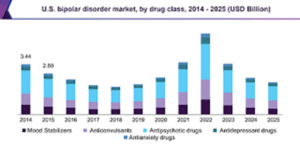
Figure 1: This figure displays the type of drugs commonly popular over the years and projects the “top” drugs in the near future [2].

Figure 2: This bar graph indicates the prevalence and burden of bipolar disorder, separated by male and female. Females are shown to be more commonly diagnosed with bipolarism than men [3].

Figure 3: As one can observe, this imaging of an individual with bipolar disorder has structural abnormalities associated with the cortical and subcortical regions, indicating potential degradation over time from mood episodes [8].

Figure 4: A: left, indicates a CT scan of a healthy brain compared to B, right, in a BD-diagnosed patient [9,10]. This patient, at the time, was a 61-year-old female diagnosed with BD for the past 46 years. A and b in figure show axial images at the level of body of caudate and corona radiata, c shows a reformatted image in the frontal region, and d shows a sagittal reformatted region. These scans are reported to shows signs of atrophy of the cerebral parenchyma in the frontal region with the resultant prominence of the extra CSF spaces [10].
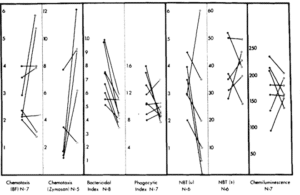
Figure 5: This figure represents granulocyte function in vitro. The data gathered from the participants (n) are depicted for each of the granulocyte function tests. Values for each subject are compared before and after a course of lithium carbonate [15].

Figure 6: This figure shows the change in CD34+ cell counts and peripheral blood neutrophil after the administration of lithium carbonate therapy in eight patients. Weekly neutrophil counts are represented by the bars and the change in the CD34+ cell counts are displayed through the lines [17].
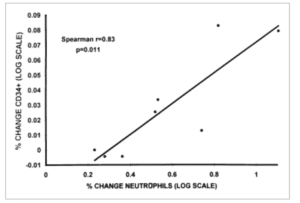
Figure 7: This figure displays the results of an increased number of CD34+ cell counts and peripheral blood neutrophil [17].
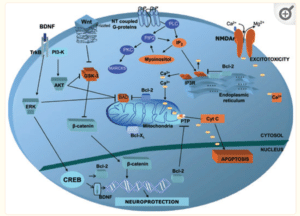
Figure 8: Image displays the targets of lithium’s immuno response. The targets in orange are pro-apoptotic proteins/receptors in which lithium works to downregulate or inhibit their expression. The proteins shown in blue are anti-apoptotic in which lithium works to act similar to an activator, encouraging a ride in expression and/or levels to induce that neurotrophic or neuroprotective response. One can also see the activation of PKC through PLC hydrolysis of PIP2 to IP3, thus releasing the ER calcium stores. Increased calcium levels intracellularly are said to increase the risk of apoptosis; thus, the Bcl-2 protein (B-cell lymphoma) works to reduce its expression through and IP3-R-dependent mechanism. Bcl-2 levels are increased in similar ways previously described. IMPase is shown to be recycling IP3 [24].
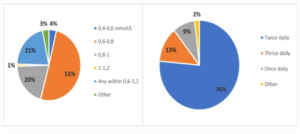
Figure 9: This figure shows the results of a questionnaire taken of 212 responses. Participants indicated what the preferred serum level of lithium should be (left) and the dose distribution it should be (right) [27].
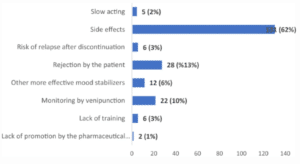
Figure 10: This figure shows the results of a questionnaire of a total of 212 responses, indicating the main reasons from participants as to why lithium should not be prescribed or treated [27].

Table 1: This table indicates the brain value comparison (amongst other clinical values) for patients experiencing psychosis versus the healthy control participants [11].


